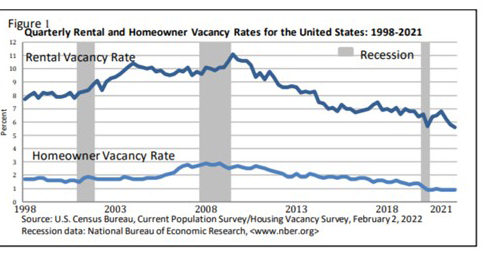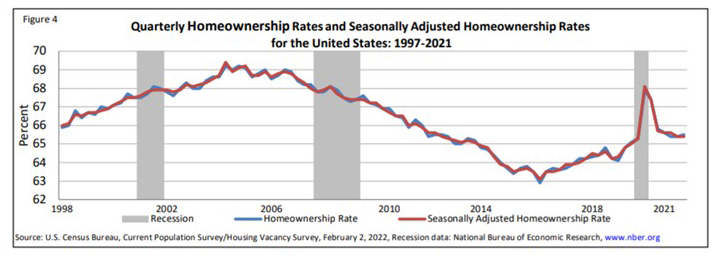
Homeownership Rate Holds Steady; Vacancy Rates Hit 38-Year Low

The nation’s homeownership rate held relatively steady at 65.5 percent in the fourth quarter, the Census Bureau reported last week. But analysts said the rate could be somewhat higher, given the current shortage of homes available for sale.

The report also noted national vacancy rates also held steady, although they were nearly 1 percent lower than a year ago. The rental vacancy rate fell to 5.6 percent for rental housing—the lowest rate in the report’s history—and 0.9 percent for homeowner housing—the lowest rate since 1983.
The report said the homeownership rate edged up slightly from the third quarter (65.4 percent) but fell slightly from a year ago (65.8 percent).

“The homeownership rate has held steady above pre-pandemic levels,” said Odeta Kushi, Deputy Chief Economist with First American Financial Corp., Santa Ana, Calif. “Millennials are still aging in large numbers into the lifestyle decisions that are correlated with the decision to buy a home. There is a longer run demographic demand shift away from renting to home owning driven by millennials aging into homeownership.”
Kushi said the homeownership rate is being held back by supply. “You can’t buy what’s not for sale,” she said. “The rental vacancy rate in the fourth quarter of 2021 hit a 38-year low, while the homeowner vacancy rate remained at the lowest level in the series’ history. Our analysis shows that in the fourth quarter of 2021, the housing deficit increased and is now about 1.76 million units.”
Other key findings:
–The rental vacancy rate was highest outside metropolitan areas (7.7 percent), followed by the rate in principal cities (5.7 percent) and lowest in the suburbs (5.1 percent). The rates in the suburbs and in principal cities were lower than the fourth quarter 2020 rates, but the rate outside MSAs was not statistically different from fourth quarter 2020 rate.

–The homeowner vacancy rate in the suburbs (0.7 percent) was lower than the rates in principal cities (1.1 percent) and outside MSAs (1.0 percent), but the rates in principal cities and outside MSAs were not statistically different from each other. The rate in the suburbs was lower than the rate in fourth quarter 2020, but the rates in principal cities and outside MSAs were not statistically different from the fourth quarter 2020 rates.
–The rental vacancy rates in the Midwest (6.5 percent) and South (6.9 percent) were higher than the rates in the Northeast (4.3 percent) and West (4.0 percent). However, the rates in the Midwest and South were not statistically different from each other, and, likewise, the rate in the Northeast was not statistically different from the West. The rates in the Northeast, Midwest, and West were lower than their fourth quarter 2020 rates. The rate in the South was not statistically different from the fourth quarter 2020 rate.
–The homeowner vacancy rates in the Midwest (0.9 percent) and South (0.9 percent) were higher than the rate in the West (0.7 percent) but not statistically different from the rate in the Northeast (0.8 percent). The rates in the Midwest and South were virtually the same, and the rates in the Northeast and West were not statistically different from each other. The rates in the Northeast and South were lower than the rates in the fourth quarter 2020, while rates in the Midwest and West were not statistically different from the fourth quarter 2020 rates.
–The report said 89.5 percent of the housing units in the United States in the fourth quarter 2021 were occupied; 10.5 percent were vacant. Owner-occupied housing units made up 58.6 percent of total housing units, while renter-occupied units made up 30.9 percent of the inventory in the fourth quarter 2021. Vacant year-round units comprised 7.9 percent of total housing units, while 2.6 percent were vacant for seasonal use.
Census said 1.9 percent of total units were vacant for rent, 0.5 percent were vacant for sale only and 0.7 percent were rented or sold but not yet occupied. Vacant units that were held off market comprised 4.8 percent of the total housing stock – 1.4 percent were for occasional use; 0.8 percent were temporarily occupied by persons with usual residence elsewhere; and 2.6 percent were vacant for other reasons.
